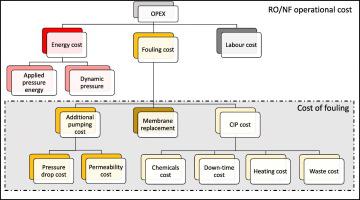Desalination ( IF 8.3 ) Pub Date : 2020-12-19 , DOI: 10.1016/j.desal.2020.114865 M. Jafari , M. Vanoppen , J.M.C. van Agtmaal , E.R. Cornelissen , J.S. Vrouwenvelder , A. Verliefde , M.C.M. van Loosdrecht , C. Picioreanu

|
The economic impact of fouling in spiral wound membranes is not yet well explored. There has been an established assumption that the cost of fouling in membrane processes is significant, but this hypothesis has not been thoroughly evaluated. We conducted an economic analysis on seven full-scale installations, four nanofiltration (NF) and three reverse osmosis (RO), to estimate the cost of fouling in industrial plants. The cost of fouling was calculated in detail, including costs of increase in feed channel pressure drop, water permeability reduction, early membrane replacement, and extensive cleaning-in-place (CIP). The estimated cost of fouling was expressed as a fraction of operational expenses (OPEX) for each plant and the major cost factors in fouling and CIP costs were identified.
The selected NF plants were fed with anoxic ground water, while the feed water to RO plants was either surface water or municipal wastewater effluent. All the NF plants produce drinking water, while the RO plants produce demineralized water for industrial applications. We found that the cost of fouling in the RO plants was around 24% of OPEX, while the fouling related costs in NF cases was only around 11% due to the low biofouling potential of the anoxic ground water. The major factor in the cost of fouling is the early membrane replacement cost, followed by additional energy and with only a minor contribution from the cleaning costs. The down-time cost (caused by the interruption of water production during a CIP event) can be the major CIP cost factor for the plants with frequent cleaning events, while the cost of chemicals dominates in the plants with non-frequent CIP. In case of manual cleaning-in-place, the cost of fouling is increased by around 2% for the RO plants with frequent CIP. The manual execution of CIP cleaning is an attention point to reconsider, as the reviewed plants hold an automated CIP cleaning, providing membrane productivity advantages.
中文翻译:

荷兰大规模反渗透和纳滤装置的结垢成本
尚未充分探索螺旋缠绕膜结垢的经济影响。已经建立的假设是,膜工艺中的结垢成本是巨大的,但是尚未完全评估该假设。我们对七个大型装置,四个纳滤(NF)和三个反渗透(RO)进行了经济分析,以估算工业厂房中的结垢成本。详细计算了结垢成本,包括进料通道压降增加,水渗透率降低,早期更换膜和广泛的就地清洗(CIP)成本。估计的结垢成本表示为每个工厂的运营费用(OPEX)的一部分,并确定了结垢和CIP成本中的主要成本因素。
选定的NF工厂用缺氧地下水供水,而RO工厂的给水则是地表水或市政废水。所有NF工厂都生产饮用水,而RO工厂则生产用于工业应用的软化水。我们发现反渗透工厂的结垢成本约为OPEX的24%,而NF案例中与结垢相关的成本仅为11%左右,原因是缺氧地下水的生物结垢潜力较低。结垢成本的主要因素是早期的膜更换成本,其次是额外的能量,而清洁成本的贡献很小。对于发生频繁清洁事件的工厂,停机时间成本(由CIP事件中的水生产中断引起)可能是主要的CIP成本因素,而化学药品的成本在不经常使用CIP的工厂中占主导地位。如果采用人工就地清洗,则频繁进行CIP的反渗透设备的结垢成本将增加约2%。手动执行CIP清洗是重新考虑的注意点,因为经过审查的工厂拥有自动CIP清洗功能,具有膜生产率的优势。











































 京公网安备 11010802027423号
京公网安备 11010802027423号